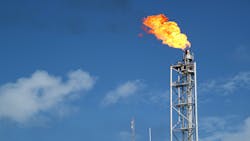Digital Flare Management: how flare.IQ transformed emissions control at a NGL facility
Key Highlights
- Flare efficiency increased from 66.5% to 94% at a Middle East NGL facility
- Methane emissions reduced by 78%, significantly lowering environmental impact
- Steam consumption dropped by 78%, improving cost and energy efficiency
- Real-time CE/DRE monitoring replaced static assumptions with dynamic control
- Compliance achieved with OGMP Level 4 standards for flare performance
The Need for Smarter Flare Management
As global energy companies race toward net-zero carbon goals by 2050, one of the most pressing challenges remains the reduction of greenhouse gas emissions from flaring operations. Flaring, a necessary safety and operational practice in oil and gas facilities, is also a significant source of methane emissions—a greenhouse gas 86 times more potent than CO₂ over a 20-year period.
Panametrics, a Baker Hughes business, has developed flare.IQ, a cutting-edge digital flare management solution designed to monitor, reduce, and control emissions from flaring. Built on ultrasonic flare flow measurement technology, flare.IQ offers real-time combustion efficiency (CE), destruction and removal efficiency (DRE), and predictive emissions modeling (PEMS). It works across both assisted and unassisted flares, helping operators optimize combustion at the flare tip by adjusting fuel gas, steam, and air assist setpoints. This ensures high-efficiency flare combustion—exceeding 98%—and supports compliance with OGMP 2.0 Level 4 standards. [www.panametrics.com]
The Challenge: Acid Gas Flaring in a Densely Populated Area
In a recent pilot project, a major operator in the Middle East partnered with Panametrics to deploy flare.IQ at one of its Natural Gas Liquids (NGL) production trains. The facility used a steam-assisted acid flare, which posed unique challenges. Acid gas flaring carries risks of unburned hydrogen sulfide (H₂S) emissions, which can lead to odor complaints and health hazards—especially in nearby urban areas.
Although flare tip designs typically claim a DRE of 98%, independent studies have shown that actual performance can be significantly lower, particularly in assisted flares. This discrepancy prompted the operator to seek a more accurate and dynamic solution for flare performance monitoring.
The Solution: Deploying flare.IQ for Real-Time Optimization
Panametrics worked closely with the operator’s R&D team to pre-program flare.IQ with all relevant flare data, including vent gas composition, temperature, pressure, and flow velocities. Once installed and commissioned, flare.IQ began delivering real-time insights into flare performance, enabling the operator to make informed adjustments to steam and fuel gas inputs.
The system’s advanced analytics platform allowed for continuous monitoring of combustion efficiency and emissions, replacing static assumptions with dynamic, data-driven control. This not only improved environmental compliance but also enhanced operational transparency and cost efficiency.
Results: Dramatic Reductions in Emissions and Operational Costs
Following extensive testing and performance review, the results were compelling:
- Flare efficiency improved from 66.5% to 94%
- Methane emissions dropped by 78%, from 0.09 tons/hour to 0.02 tons/hour
- CO₂ equivalent emissions reduced by 82%, from 2.21 tons/hour to 0.39 tons/hour
- Steam consumption decreased by 78%, from 1.12 tons/hour to 0.25 tons/hour
- Fuel gas usage also declined, contributing to further cost savings
- Smokeless operation achieved in cascade mode
- Compliance with OGMP Level 4 standards
These results not only validated the effectiveness of flare.IQ but also highlighted its potential for broader deployment across the operator’s facilities. Panametrics is now exploring options to upgrade field instrumentation and scale the solution enterprise-wide.
Why flare.IQ Stands Out
flare.IQ is more than just a monitoring tool—it’s a full-stream flare control solution. Its key differentiators include:
- Digital Verification: Enables remote validation of flare meters, reducing the need for manual inspections and scaffolding, thereby improving safety and reducing HSE risks.
- Real-Time CE/DRE Monitoring: Uses parametric modeling based on experimental data and CFD calculations to deliver accurate combustion efficiency metrics.
- Predictive Emissions Modeling (PEMS): Provides real-time estimates of CO₂, CO, VOCs, and methane emissions, supporting transparent reporting and regulatory compliance.
- Flexible Deployment: Works with both assisted and unassisted flares, making it suitable for upstream, midstream, and downstream operations.
- Cost Efficiency: Reduces steam and fuel gas usage, minimizes carbon tax liabilities, and supports ESG goals.
Industry Impact and Future Outlook
The success of the flare.IQ pilot at the NGL facility underscores the growing importance of digital solutions in flare management. As methane emissions continue to be a focal point in climate strategies, technologies like flare.IQ offer a scalable, cost-effective path to measurable impact.
With increasing regulatory pressure and corporate sustainability commitments, flare.IQ is poised to become a cornerstone of emissions reduction strategies in the oil and gas sector.
The pilot project at the Middle East NGL facility demonstrates how flare.IQ can transform flare operations from a static, compliance-driven process into a dynamic, data-informed system. By improving combustion efficiency, reducing emissions, and lowering operational costs, flare.IQ empowers operators to meet environmental goals without compromising performance.
As Panametrics continues to innovate and expand its flare management portfolio, flare.IQ stands as a testament to the power of digital transformation in achieving a cleaner, more efficient energy future. [www.panametrics.com]

